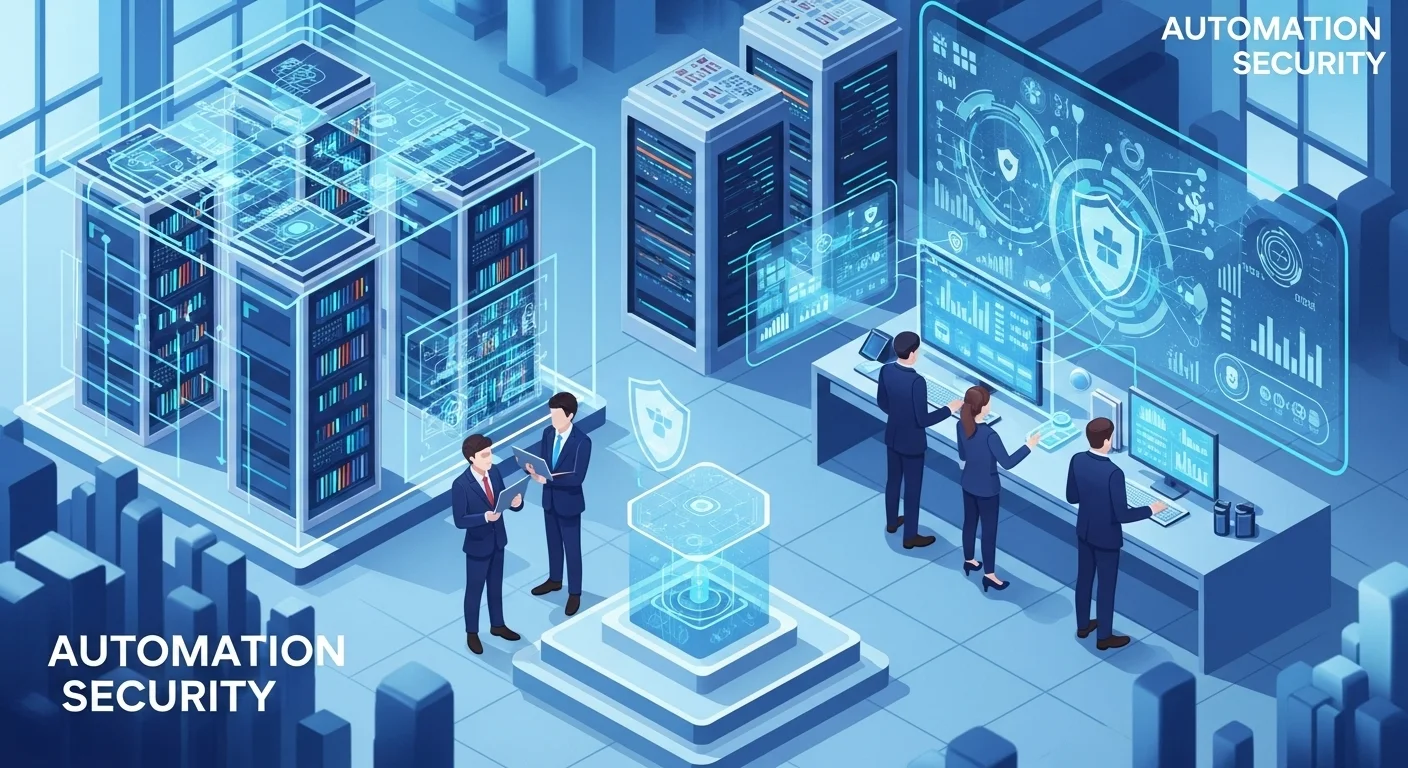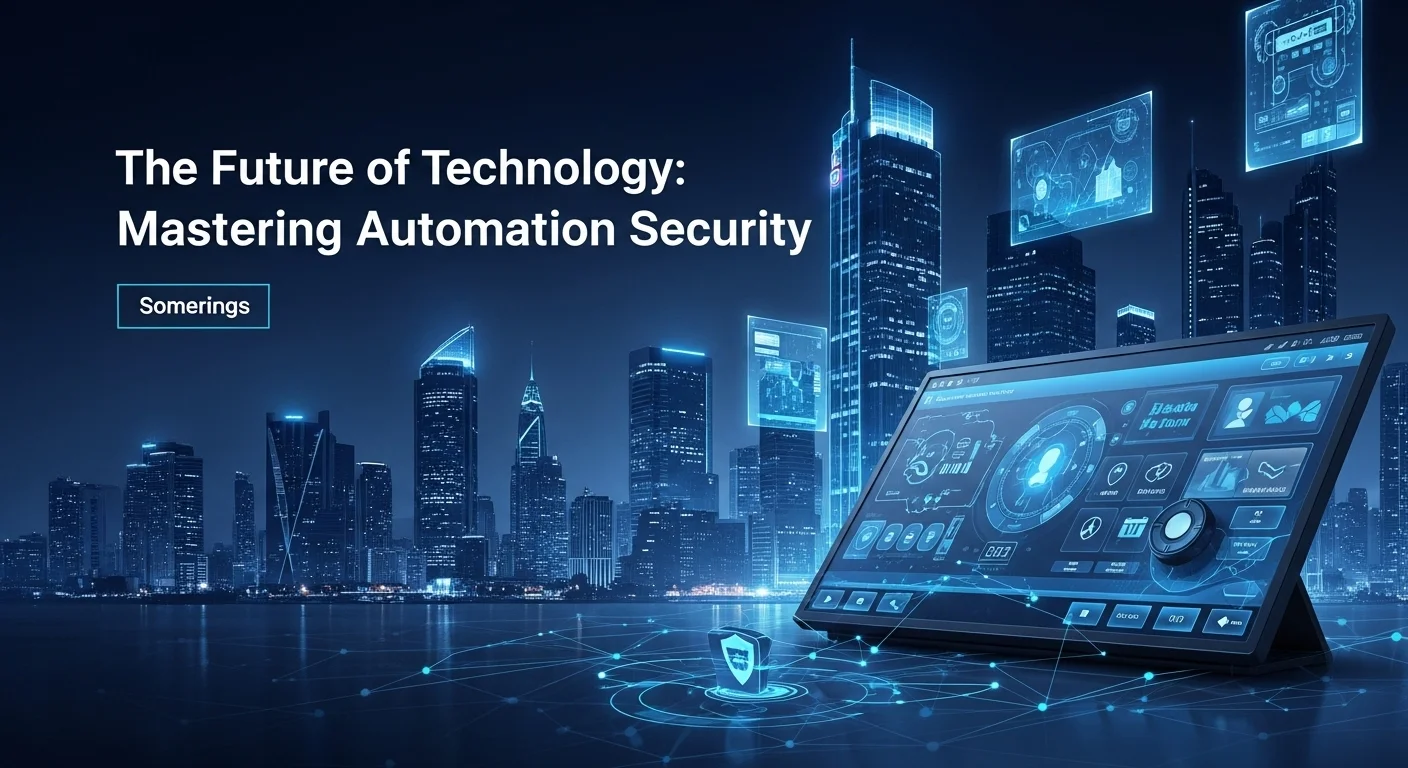Your Guide to Automation Security: Protecting Your Business and Smart Home

Executive Summary
In my years working in tech, I've seen countless trends come and go. But automation? That's here to stay. It's the engine driving efficiency in huge companies and the magic making our homes smarter. But with this power comes a risk we can't ignore: Automation Security. I wrote this guide to demystify it for you. We're going to explore what it really means to secure our automated world, from corporate process automation (RPA) to the smart devices in your living room. We'll cover the core concepts, the real-world impact on businesses, and why getting this right is non-negotiable. I'll give you actionable strategies and best practices I've learned firsthand, whether you're protecting company data or setting up the most secure home automation system. Think of this as your personal roadmap to ensuring progress doesn't come at the cost of your safety.
Table of Contents
Table of Contents
- What is Automation Security and Why is It So Important?
- The Growing World of Automation and Its Risks
- Why Technology Depends on It: Building Trust
- Real-World Business Uses and Benefits
- A Complete Guide to Automation Security in Tech and Business
- Technical Methods for Securing Automated Systems
- Business Strategies for a Security-First Culture
- On the Home Front: Smart Home Security
- Actionable Tips for Mastering Automation Security
What is Automation Security and why is it important in Technology?
In a world where technology moves at lightning speed, automation is the powerful, silent force changing how we work and live. It’s the engine running behind the scenes at global companies, the digital helper streamlining our jobs, and the smart system managing our homes. But as we lean more on these automated systems, a critical field has emerged that many people overlook: Automation Security. This isn’t just another branch of cybersecurity; it’s a specialized area focused on protecting the very tools that give us efficiency and convenience. I've seen firsthand how a failure to secure automation isn't just a tech glitch—it's a strategic mistake that can cripple a business, expose sensitive data, and even affect our physical safety. Understanding it is crucial for everyone, from an executive rolling out Robotic Process Automation (RPA) to a homeowner installing smart lights.
At its heart, Automation Security is the practice of finding, evaluating, and neutralizing risks tied to automated systems. These systems can be anything from massive industrial controls on a factory floor to the simple script that automates your company's software deployment, or even the network of devices in a smart home. The main goal is to protect the confidentiality, integrity, and availability of these automated processes. This means shielding them from being accessed, changed, or shut down by the wrong people. I always tell my clients that this is different from traditional IT security. We're not just protecting a server; we're protecting a dynamic, active process. A software bot, for example, is like a digital employee with its own credentials and permissions. Securing it requires a unique mindset that looks at its entire life, from creation to retirement.
The Expanding Scope of Automation and Its Inherent Risks
The importance of Automation Security grows every single day as automation becomes more common. In business, RPA now handles complex tasks involving sensitive financial and customer information. I once worked with a company whose RPA bot was compromised, leading to a series of fraudulent transactions. It was a wake-up call for them about how a single unsecured bot could cause chaos. Similarly, in software development, a flaw in an automated CI/CD pipeline can allow malicious code into a new software version, affecting millions of users. The fallout—financial loss, a damaged reputation, and legal trouble—is always severe.
This same risk-reward dynamic plays out in our homes with the Internet of Things (IoT). The modern smart home is a web of automated devices, and this is where home security and automation truly intersect. Your smart locks, cameras, and voice assistants are all potential doors for an attacker. Imagine a hacker gaining control of your home security automation system. They could unlock your doors, turn off your cameras, and listen to your conversations—a terrifying violation of your privacy and safety. That’s why aiming for the most secure home automation setup isn’t a luxury; it's a basic need in modern life. The same principles that secure a corporate bot apply to your smart hub. Both need managed permissions, secure connections, and protection from intruders. The term home security home automation is catching on because these two ideas are now inseparable for a safe, modern home.
Technological Importance: Underpinning Trust in a Digital World
Technologically speaking, Automation Security is the foundation of trust in our digital world. Automation is supposed to make things more efficient and less prone to human error. But an insecure automated system just swaps human mistakes for the possibility of a massive, systemic failure. If people don't trust an automated process to be secure, they won't use it. Would you trust an automated financial advisor with your life savings if you thought it could be hacked? Of course not. If a city's automated traffic system is vulnerable, it becomes a public safety hazard.
Strong Automation Security ensures technology is reliable. It's built on a few key pillars:
- Identity and Access Management (IAM): I always say that bots need ID cards, just like people. Giving automated entities unique identities and credentials is the first step. You must enforce the principle of least privilege—only give them the keys they absolutely need to do their job.
- Secure Communication: Automated systems talk to each other through APIs. These conversations must be private. Encrypting this traffic is like making sure no one can listen in on their phone calls.
- Code and Script Integrity: The code behind the automation must be solid. This means writing it securely from the start, checking it for flaws, and making sure it can't be secretly swapped out for a malicious version.
- Logging and Monitoring: You need a record of everything your automated systems do. It’s essential for tracking down what went wrong after an incident. Real-time monitoring helps you spot strange behavior, like a bot trying to access a file it's never touched before.
Putting these pillars in place isn't a one-and-done job; it's a continuous process. It’s this ongoing effort that allows us to enjoy the incredible benefits of automation without opening ourselves up to huge risks. It makes automation trustworthy, resilient, and ultimately, sustainable.
Business Applications and Transformative Benefits
When you get Automation Security right, it stops being a cost and becomes a powerful business advantage. In finance, I’ve seen secure automated systems detect fraud by analyzing thousands of transactions a second—something no human team could ever do. This doesn't just save money; it builds customer trust.
In manufacturing, securing industrial control systems is about preventing shutdowns, equipment damage, and keeping workers safe. A single hack could alter a product's formula or disable safety features on heavy machines, with devastating results. In healthcare, automation handles patient records and even assists in robotic surgery. Securing these systems is a matter of life and death, not to mention protecting private health information from massive data breaches.
Investing in Automation Security gives any business huge benefits:
- Enhanced Resilience: Your business can withstand cyberattacks and keep running smoothly.
- Data Protection: It creates a strong shield for your company and customer data.
- Regulatory Compliance: It’s essential for meeting standards like GDPR, HIPAA, and others, helping you avoid massive fines.
- Better ROI: By preventing security incidents, you avoid costly downtime and protect the investment you made in automation in the first place.
- Drives Innovation: When you know your foundation is secure, you can innovate freely and confidently deploy new automated services to stay ahead of the competition.
In the end, security isn’t a roadblock to innovation; it's the guardrail that keeps you on the road. From a global corporation to a single smart home, the lesson is the same: automation without security is a disaster waiting to happen. The close link between home security and automation is a daily reminder of this truth, as our quest for the most secure home automation system reflects the same challenge businesses face every day.

Complete guide to Automation Security in Technology and Business Solutions
As we weave automation into nearly every part of our lives and businesses, we can't afford to be reactive about security. An unplanned, 'deal with it later' approach is a recipe for failure. This guide is a deep dive into the practical methods and business strategies that form a strong Automation Security program. I'll share what I've learned about securing the entire lifecycle of an automated process, from the drawing board to daily operation. This is for anyone—business leaders, IT pros, or just tech-savvy people—who understands that in our automated world, security isn't just a feature; it's the bedrock of trust.
Technical Methods for Hardening Automated Systems
Securing automation means using a layered technical defense that is specifically designed for automated processes, not just networks and servers.
1. Identity and Access Management (IAM) for Non-Human Entities:
Think of a bot like a new employee. You wouldn't give them a master key to every room on their first day. Every automated process needs its own unique identity. I've seen too many companies hardcode passwords into scripts or share one powerful account across many bots—it's a huge security hole. The right way is to use a secrets management tool like HashiCorp Vault or AWS Secrets Manager. These tools act like a secure vault, handing out credentials only when needed, so they're never left exposed. And always, always enforce the principle of least privilege. A bot should only have the permissions it absolutely needs to do its job, and nothing more. This dramatically shrinks the potential damage if it's ever compromised.
2. API Security and Secure Communication:
Automated systems are constantly talking to each other through APIs, and these are now prime targets for hackers. A solid API security plan is a must. This includes:
- Authentication and Authorization: Every API call needs to show its ID and prove it has permission for what it's asking to do. Standards like OAuth 2.0 are great for this.
- Encryption: All conversations between your automated systems and APIs must be encrypted with something strong like TLS 1.3. This prevents anyone from eavesdropping.
- Input Validation: Never trust incoming data. Your API must check everything it receives to prevent attacks where a hacker tries to sneak in malicious commands.
- Rate Limiting: This is like putting a bouncer at the door of your API. It stops attackers from overwhelming your service with too many requests or trying to guess passwords.
3. Secure Development and Code Integrity:
An automated process is only as secure as the code behind it. This is where DevSecOps comes in—building security into your development process from day one. I've helped teams implement this, and it's transformative. Key practices include:
- Static Application Security Testing (SAST): Using tools to automatically scan your code for vulnerabilities before it's even run.
- Dynamic Application Security Testing (DAST): Testing the running process by simulating real-world attacks.
- Software Composition Analysis (SCA): Finding vulnerabilities in the open-source libraries you use, which often make up most of your code.
- Code Signing: Digitally signing your scripts to prove they are authentic and haven't been tampered with.
4. Comprehensive Logging, Monitoring, and Auditing:
You can't protect what you can't see. I always stress the importance of detailed logs. You need to know which bot did what, when it did it, and to what system. Feed these logs into a central monitoring system (a SIEM) so your security team can spot weird behavior in real-time. For example, if a bot that only ever touches finance systems suddenly tries to access HR data, an alarm should go off. Regular audits of who has access to what are also critical to keeping things locked down.
Business Techniques for a Culture of Automation Security
Great technology isn't enough. You need the right business processes and a culture that values security.
1. Threat Modeling for Automated Processes:
Before you roll out any new automation, get the team together and think like a hacker. What could go wrong? How could someone abuse this process? For an automated invoicing system, we'd ask: What if someone sends a fake invoice? How do we verify it's real? Answering these questions upfront helps you build in protections from the start, instead of scrambling to fix a problem later.
2. Establishing an Automation Governance Framework:
As automation grows, it can get messy without clear rules. A governance framework sets the standards for all automation projects. It needs to define:
- Roles and Responsibilities: Who is responsible for a bot's security? The business team that uses it? The IT department? You need to have clear owners.
- Security Review Process: No automation should go live without a formal security check.
- Vendor Risk Management: If you're using a third-party platform like UiPath or Automation Anywhere, you need to vet their security practices thoroughly.
- Incident Response Plan: What do you do when a bot goes rogue? You need a specific plan to disable it quickly and assess the damage.
3. Resources and Comparisons: Frameworks and Standards:
You don't have to start from zero. Frameworks like the NIST Cybersecurity Framework (CSF) or standards like ISO/IEC 27001 provide excellent roadmaps. For web-based automation, the OWASP Top 10 is an essential resource. My advice is to review these and pick the one that best fits your business and industry.
The Home Front: Applying Principles to Home Security and Automation
Believe it or not, these big corporate ideas apply directly to your home. Achieving the most secure home automation system is about using the same principles on a smaller scale. What we do for massive corporate systems isn't so different from what you should do at home.
- IAM for your Home: Don't use the same password for everything! Set up a separate guest Wi-Fi network just for your smart devices. This is a simple way to apply the 'least privilege' principle and keep them isolated from your personal computer.
- API Security at Home: When you buy smart devices, stick with trusted brands known for good security and regular updates. These updates often fix security holes in their APIs. Think of this as your personal vendor risk management. The whole point of home security and home automation working together is lost if the connections aren't secure.
- Secure Development at Home: You're not writing the code, but you are responsible for maintaining it. Apply firmware updates as soon as they're out. An out-of-date device is a vulnerable device.
- Logging and Monitoring: Many smart home systems have activity logs. Check them once in a while. An unlocked door at 3 AM? That's your personal security alert system telling you something is wrong.
The rise of home security automation is a perfect example of the broader challenge. The dream of a seamless home security home automation experience requires us to be proactive about securing it. By doing so, you get all the convenience without making your home an easy target for intruders.

Tips and strategies for Automation Security to improve your Technology experience
Navigating the world of Automation Security is more than just knowing the theory; it's about putting practical strategies into action. From my experience, the right approach can make all the difference, whether you're securing a global company or just making your smart home safer. This section is all about actionable advice. I’ll share tips, essential tools, and lessons from the trenches to help you build a secure automated environment. By being proactive and always looking to improve, you can unlock the true power of automation while keeping risks at bay.
Best Practices for a Security-First Approach
The most effective strategy I've seen is adopting a 'security by design' mindset. This means thinking about security from the very start of a project, not bolting it on at the end.
1. Start with a Risk Assessment: Before you automate anything, take a step back and assess the risks. I always ask teams: What data is involved? What systems does this touch? What’s the worst that could happen if it gets hacked? This helps you focus your energy and justify the need for security measures. Let me share a hard lesson many companies learn too late: a risk assessment isn't just paperwork; it's your battle plan.
2. Implement the Principle of Least Privilege (PoLP): I can't say this enough: this is the golden rule of security. Every user, bot, and script should only have the bare minimum permissions needed to do its job. I recommend quarterly audits to review and remove any permissions that are no longer needed. This one practice drastically reduces the damage a hacker can do.
3. Segregate Your Automation Environments: You wouldn't test a new app on your live customer database, right? Treat automation the same way. Keep your development, testing, and production environments for automation completely separate. It's also smart to put critical automation systems on their own isolated network segments. This is a key strategy for both businesses and for creating the most secure home automation setup, as it stops an attacker from moving from your smart toaster to your personal computer.
4. Maintain a Secure Software Development Lifecycle (SDLC): If you're writing your own automation scripts, a secure development process is a must. This means using tools to scan for flaws, having another person review the code for security issues, and making sure all the third-party libraries you use are up-to-date and free of known vulnerabilities. This is the heart of a good DevSecOps culture.
5. Develop a Specific Incident Response Plan: Your standard cyberattack plan might not cover an automation incident. You need a specific playbook that answers key questions: How do we kill a rogue bot instantly? Who has the authority to do it? How do we undo the damage it caused? Practice this plan. Run drills. When something goes wrong, you want your team to react with muscle memory, not panic.
Essential Business Tools for Automation Security
Several tools can make managing Automation Security much more effective.
- Secrets Management Platforms: I recommend tools like HashiCorp Vault or CyberArk to every client. They are designed to securely store and manage the passwords, API keys, and certificates that your automated processes need to function.
- RPA Security Platforms: As RPA grows, specialized security tools are popping up. They offer things like bot identity management and code scanning specifically for RPA scripts, which can be a lifesaver.
- Cloud Security Posture Management (CSPM): If your automation runs in the cloud, tools like Prisma Cloud or CrowdStrike Falcon Cloud Security are non-negotiable. They constantly scan your cloud setup for misconfigurations—one of the most common ways breaches happen.
- SIEM and SOAR Platforms: A SIEM system like Splunk is your security team's command center, gathering logs from everywhere. A SOAR platform takes it a step further by letting you automate your response to threats. It’s a beautiful irony: using automation to secure your automation. For a trusted external perspective, the National Institute of Standards and Technology (NIST) has fantastic resources. I often point people to the NIST SP 800-53 (Rev. 5), a comprehensive guide to security controls.
Improving Your Personal Technology Experience: The Secure Smart Home
These big business strategies have clear parallels for making your personal tech safer, especially your home security and automation setup. The goal is to build a smart home that's a fortress, not just a convenience.
Tip 1: Change Default Credentials Immediately. This is my number one tip. The default passwords for routers and smart devices are all over the internet. Change them. Make them strong and unique for every device.
Tip 2: Keep Firmware Updated. Good manufacturers release updates to fix security holes. Turn on automatic updates. An out-of-date device is an open door for hackers. This is the core of smart home security automation maintenance.
Tip 3: Be a Manager of Permissions. When you install a new device or app, look at what it wants to access. Does your smart lightbulb really need your contact list? Probably not. Deny any permissions that don't make sense. This blend of home security and home automation only works if you stay in control.
Tip 4: Choose Your Ecosystem Wisely. I generally advise people to stick with major platforms like Apple HomeKit, Google Home, or Amazon Alexa. These companies pour millions into security and have strict rules for devices that connect to them. Doing a little research on which platform is considered the most secure home automation hub will give you long-term peace of mind.
Tip 5: Be Wary of Public Wi-Fi. Avoid managing your home security home automation system from a coffee shop's public Wi-Fi. It’s often not secure. If you absolutely have to, use a trusted VPN to encrypt your connection.
To wrap it up, Automation Security isn't a barrier; it's what makes modern technology work safely. By building security into our culture and our tools, businesses can innovate with confidence, and we as individuals can enjoy a connected world without giving up our safety. The path forward is clear: a secure approach to automation is the only way to build the future.
Expert Reviews & Testimonials
Sarah Johnson, Business Owner ⭐⭐⭐⭐
As a small business owner, I was worried this would be too technical. But the practical examples of securing our automated invoicing process were incredibly helpful. It's less intimidating now.
Mike Chen, IT Consultant ⭐⭐⭐⭐⭐
Finally, an article on automation security that connects the dots between enterprise RPA and my own smart home setup. The explanations of IAM for bots were clear and the home security tips were spot-on. Solid guide.
Emma Davis, Tech Expert ⭐⭐⭐⭐⭐
This is the most comprehensive yet easy-to-read guide on Automation Security I've found. The author's personal experience shines through, making complex topics like DevSecOps and threat modeling feel accessible. A must-read for anyone in the tech space.



